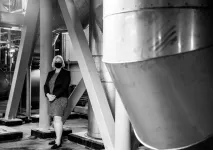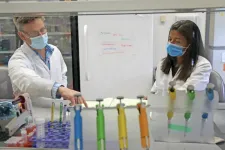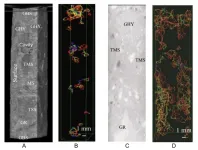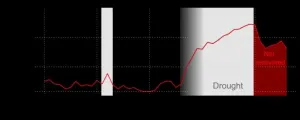INFORMATION:
"Paradigm shift" needed in view of respiratory infection risk from indoor ventilation systems
2021-05-13
(Press-News.org) For decades, governments worldwide have invested great deals of legislation and resources in food safety, sanitation and drinking water quality for public health purposes. However, the same cannot be said for the air quality of indoor public spaces, wherein the spread of airborne pathogens - whether those that cause the common cold or COVID-19 - is generally considered to be an "inescapable part of daily life." In a Policy Forum, Lidia Morawska and colleagues argue for a profound shift in how policymakers and building engineers view and approach indoor air quality and health, to reduce the spread of respiratory infection. According to Morawska et al., similarly to how food and waterborne disease have largely been eliminated in developed countries, achieving clean, pathogen-free air in buildings and indoor public spaces is possible. However, doing so will require a "paradigm shift" in how this risk is viewed and addressed by scientists, engineers, and public health officials. The authors propose several next steps, including development of recommendations on preventive measures addressing all modes of respiratory infection transmission in a proper and balanced way, based on state-of-the-art science. They note the recently published WHO Ventilation Roadmap is "an important step" but say it falls short of recognizing the hazard of airborne respiratory infection transmission, and in turn, the necessity of risk control. "The COVID-19 pandemic has revealed how unprepared the world was to respond to it, despite the knowledge gained from pandemics that have occurred over past centuries," write the authors. "In the 21st century, we need to establish the foundations to ensure that the air in our buildings is clean with a substantially reduced pathogen count, contributing to the building occupants' health just as we expect for the water coming out of our taps."
ELSE PRESS RELEASES FROM THIS DATE:
Neurons in brain's "zona incerta" drive curiosity in mice
2021-05-13
A subpopulation of neurons in the brain's zona incerta, or "zone of uncertainty," drives investigatory and novelty-seeking behavior in mice, according to a new study. The findings reveal a previously unknown brain circuit underlying innate curiosity; its discovery may one day have implications as a therapeutic target in animals or people who exhibit novelty-seeking behaviors, authors of a related Perspective say. Although curiosity - the motivational drive to investigate the unknown - is widely considered to be as intrinsic as hunger and thirst, and an ...
After the rains return, watersheds may not always recover from drought
2021-05-13
Challenging the assumption that watershed streamflow always recovers from drought, a new study done seven years after the "Millennium Drought," the worst drought ever recorded in southeastern Australia, reports that more than a third of the region's affected watersheds had not yet recovered. Of these watersheds that were still dry seven years later, most showed no evidence of recovering soon, despite the rains' return. The new study's findings suggest that hydrological droughts can persist indefinitely after meteorological droughts, highlighting an amplification of climate change impacts that could present additional challenges to the sustainable use of already-threatened water ...
Letter from scientists: Investigate the origins of COVID-19
2021-05-13
More investigation is needed to determine the origin of the COVID-19 pandemic, say Jesse Bloom, Alina Chan, Ralph Baric, David Relman and colleagues in this Letter. "Theories of accidental release from a lab and zoonotic spillover both remain viable," they say. "Knowing how COVID-19 emerged is critical for informing global strategies to mitigate the risk of future outbreaks." The authors highlight a joint China-World Health Organization (WHO) report into the origins of SARS-CoV-2, some results of which were released in November 2020. "WHO Director-General Tedros Ghebreyesus commented that the report's consideration of evidence supporting a laboratory ...
To prevent next pandemic, scientists say we must regulate air like food and water
2021-05-13
Humans in the 21st century spend most of their time indoors, but the air we breathe inside buildings is not regulated to the same degree as the food we eat and the water we drink. A group of 39 researchers from 14 countries, including two from the University of Colorado Boulder, say that needs to change to reduce disease transmission and prevent the next pandemic.
In a Perspectives piece published in Science May 14, they call for a "paradigm shift" in combating airborne pathogens such as SARS-CoV-2, the virus that causes COVID-19, demanding universal recognition that respiratory infections can be prevented by improving indoor ventilation systems.
"Air can contain viruses just as water and surfaces do," said co-author Shelly Miller, professor of mechanical and ...
What makes plant cell walls both strong and extensible?
2021-05-13
UNIVERSITY PARK, Pa. -- A plant cell wall's unique ability to expand without weakening or breaking--a quality required for plant growth--is due to the movement of its cellulose skeleton, according to new research that models the cell wall. The new model, created by Penn State researchers, reveals that chains of cellulose bundle together within the cell wall, providing strength, and slide against each other when the cell is stretched, providing extensibility.
The new study, which appears online May 14 in the journal Science, presents a new concept of the plant cell wall, gives insights into plant cell growth, and could provide inspiration for the design of polymeric materials with new properties.
"For a long time, the prevailing ...
Brain mechanism of curiosity unraveled
2021-05-13
Curiosity is the motivational drive for exploring and investigating the unknown and making new discoveries. It is as essential and intrinsic for survival as hunger. Until recently, the brain mechanisms underlying curiosity and novelty seeking behavior were unclear. However, researchers from the Netherlands Institute for Neuroscience have now discovered a new brain circuit underlying curiosity and novelty seeking behavior. The results have been published in the scientific journal Science.
Curiosity, hunger and appetitive aggression drive three different goal-directed behaviors: novelty seeking, food eating and hunting. In animals these behaviors are composed of similar actions. This similarity of actions has made it challenging ...
Ventilation in buildings: where water sanitation was in the 1800s
2021-05-13
A group of the world's leading experts in the transmission of airborne pathogens is calling for a tightened regulatory system to control air quality in buildings - as a way of reducing the spread of covid-19 and other illnesses.
Writing in the journal Science, the 40 scientists say: "A paradigm shift is needed on the scale that occurred when Chadwick's Sanitary Report in 1842 led the British government to encourage cities to organise clean water supplies and centralised sewage systems.
"In the 21st century we need to establish the foundations to ensure that the air in our buildings is clean with a significantly reduced ...
Researchers identify a missing piece of the Lyme disease puzzle
2021-05-13
Epidemic. Pandemic. These terms have become second nature to us, popping up in everyday conversation, and for good reason -- COVID-19 is the latest pandemic to pose a threat to humanity.
But in recent months, far less attention has been paid to another widely spread problem that has been proliferating since the late 1970s: Lyme disease.
Lyme disease is the most reported vector-borne disease in the country. Over the past 20 years, the United States has experienced a dramatic increase in both the number of reported cases and the geographic distribution of the disease. In Virginia, the disease is transmitted by blacklegged ticks, which are infected with the Lyme disease-causing bacterium Borrelia ...
Causes of concrete and asphalt deterioration explained
2021-05-13
Scientists reveal that the deterioration of modern concrete and asphalt structures is due to the presence of trace quantities of organic matter in these structures.
Cement and asphalt are vital to modern construction materials; cement is used for the construction of various buildings and structures, while asphalt is primarily used for highways and runways. They have been widely used for these purposes since the 1800s. It has been observed modern concrete structures and asphalt structures tend to deteriorate much faster than historical structures, but the reason for this phenomenon was unknown.
A team of scientists from six institutions, including Akihiro ...
Victoria's watch catchments may not recover from drought: Study
2021-05-13
One-third of the water catchments included in a Victorian study had not recovered from a severe drought nearly eight years later, Australian-first research from Monash University shows.
Globally, science holds the common view that rivers and underground water supplies eventually replenish following periods of severe drought or flood.
This study, led by Dr Tim Peterson from Monash University's Department of Civil Engineering and published today in the prestigious international journal Science, is the first in the world to challenge this widely held view.
Researchers used statistical ...




